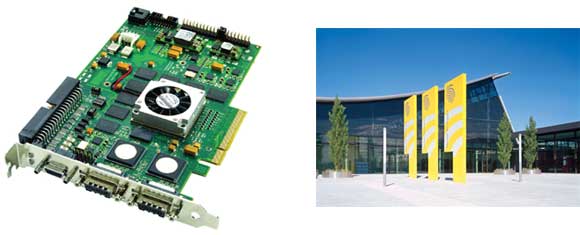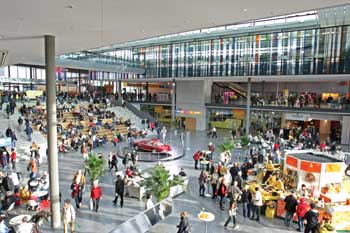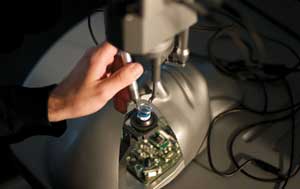As the economy starts to pick up, Vision 2011 will turn an eye on machine vision applications and complete systems for industrial and nonindustrial purposes.
A full range of machine vision components, systems, services and innovative products – including cameras, sensors, illumination sources, lasers, optics, lenses, software and frame grabbers – will be showcased at the 24th annual Vision 2011, to be presented by Messe Stuttgart at the New Stuttgart Trade Fair Centre from Nov. 8 to 10.
The 2010 show was the largest Vision event to date, drawing 6752 visitors – 500 more attendees than in the previous record year, 2008. Numbers were down to 5700 in 2009 because of the economic crisis, according to organizers.

The Xcelera HS PX8 frame grabber from Teledyne Dalsa has a PCI Express 8x interface especially for high-speed applications and will be showcased at Vision 2011. Courtesy of Teledyne Dalsa/Messe Stuttgart.
Following last year’s exhibition, Dr.-Ing. Dietmar Ley, chairman of the board of management at Basler AG in Ahrensburg, Germany, noted, “A very positive mood was noticeable. The crisis is over, and a wave of optimism is spreading again.
“We detected two trends: firstly, a low-cost trend – that is, high demand for cheaper products with standard interfaces. Secondly, there is an increased trend toward the use of cameras in applications outside factories. I am thinking here ... of applications in sport, in medicine or in craft trades – for example, for track adjustment of a car in a garage.”

The New Stuttgart Trade Fair Centre will host the 24th annual Vision 2011 trade fair, to be presented by Messe Stuttgart from Nov. 8 to 10. Various machine vision products and systems will be on display. Courtesy of Messe Stuttgart.
Visitors in 2010 came from more than 50 countries to Stuttgart; attendees came primarily but not exclusively from Europe, with strong representation from the US and South Korea. More than 300 companies presented their wares at the exhibition.
Organizers expect Vision 2011 to be even bigger.
“We are actually expecting to welcome around 7000 visitors at this year’s show, which would again be a record,” said Messe Stuttgart’s Vision project manager Florian Niethammer, who attributes the predicted increase in part to this year’s additional focus on machine vision for the medical device industry. “Aside from visitors looking for machine vision components, we are expecting more end users from the most diverse industries to come with very specific application problems in search of machine vision solutions.”
Vision 2011 will include the exhibition as well as the Industrial Vision Days technical program, which will offer daily presentations ranging in scope from new developments to user talks, career coaching, a job board and more. The Vision Award, which recognizes outstanding machine vision solutions, will be presented for the 19th time at this year’s event.
Accent on applications
One particular focus of this year’s Vision show is end-user applications. The main users of industrial machine vision are the automobile, glass, electronics, plastics, semiconductor, wood, food, pharmaceuticals, printing, textiles and clothing industries, plus mechanical engineering. But organizers report that significant, if gradual, inroads are being made by nonindustrial sectors including medical technology, life sciences, security, traffic guidance systems, cartography, entertainment, sports and more.
Interest in turnkey vision systems is on the rise, according to the show’s organizers, who plan to set up three areas for this customer base: the Integration Area, a platform for system integrators and solution providers; the Application Park, presenting practical handling, automation, packaging, labeling and quality testing applications; and user seminars, which will offer practical machine vision know-how.
The Integration Area is designed to bring users and integrators together so that the latter can demonstrate vision applications such as weld-seam monitoring, time-saving glass inspection and quality testing for micrometer structures. “In the long term, we want to create a platform at Vision that brings together system suppliers from the machine vision industry and end users who are looking for solutions for their application problems,” Niethammer said.
3-D machine vision will be one of the trade fair’s hottest topics, according to organizers, who expect high attendee interest in easier integration, higher accuracy, and better speed and reliability, especially for industrial uses. “In an era when all kinds of electronic components are becoming increasingly more complex and ever smaller, conventional 2-D test methods are reaching their limits because they do not cover the entire range of defects,” said Dieter A. Riehl, managing shareholder at Sirius Advanced Cybernetics GmbH in Karlsruhe, Germany.
The proportion of 3-D measuring tasks increased substantially from 10 to 15 percent between 2008 and 2009, according to surveys conducted in Germany and Europe by the VDMA Machine vision group and the European Machine Vision Association (EMVA). The actual figure in relation to the European machine vision industry was 16 percent. In response to this, Vision 2011 will feature the latest 3-D machine vision products, systems and applications, including 3-D image acquisition devices, and software tools for evaluating and presenting 3-D data.
“The advantage of 3-D image acquisition and machine vision,” said Dr. Tobias Henzler, a 3-D technology specialist at Stemmer Imaging GmbH in Puccheim, Germany, “is that features and defects in free-form surfaces can be detected without the shape, color or texture of the surface causing any major problems. Unlike 2-D machine vision, you also obtain metric height information.”
Faster interfaces
Another special subshow will be the fourth annual International Machine Vision Standards, which will present products featuring new standardization attempts CoaXPress and Camera Link HS. Machine vision and data interfaces go hand in hand; as image sensors in digital cameras become increasingly more efficient, even faster data transmission methods become more important.
CoaXPress and Camera Link HS came into play after Camera Link became less sufficient for some high-speed applications; version 2.0 of the GigE Vision Standard (Gigabit Ethernet) was due to be adopted in the third quarter of 2011, and the extended USB 3.0 interface is making inroads into the consumer sector.
The special segment of the trade fair was organized jointly with the Automated Imaging Association, the EMVA and the Japan Industrial Imaging Association.
The market – or, rather, the corresponding applications, for which each standard has its advantages and disadvantages – will decide which standard will ultimately prevail, organizers note. Vision 2011 will allow users to learn more about each and find the right fit for their applications. “Visitors will be able to talk directly with developers, ask them questions and make suggestions,” said Patrick Schwarzkopf, general secretary of the EMVA.
Vision for medicine
Patients and health care providers want higher quality – but they also want lower costs. “Machine vision can be a key technology here in order to combine these contradictory demands,” said Alexander Temme, sales director at Basler. And camera-based medical technology can help improve early detection, diagnosis, treatment, archiving and training methods.
To this end, medical technology also will be a featured topic at this year’s show. Applications abound in this sector and include mini cameras for endoscopies or less-invasive surgery; scanners to improve denture quality or identify skin cancer; digital cameras for ophthalmology, sports medicine and orthopedics; and systems for monitoring and documenting surgeries, and to support medical training. The VDMA Machine Vision Group will hold talks on medical technology applications as part of the Industrial Vision Days technical event.

Machine vision applications are opening up in medicine, and Vision 2011 will place a special focus on this market sector. Eyesi, an eye surgery simulator from VRmagic, allows trainee eye surgeons to perform risk-free operations. Courtesy of VRmagic/Messe Stuttgart.
A special new event, the Medical Discovery Tour, will help visitors navigate the world of machine vision for medical applications. “Machine vision is playing an ever-important role in the medical device industry,” Niethammer said. “Mini cameras with a volume of just 1 cc are used in endoscopy and operations, and in dentistry, dental impressions are now taken by digital means with the help of machine vision cameras. And also in the large-scale production of medical devices, machine vision helps in packaging and quality control, for example.
“With the Medical Discovery Tour, we are specifically addressing visitors from the medical device industry who are interested in innovative machine vision applications. A special guided tour will be conducted through the stands of the exhibitors showcasing products and applications on this topic in particular.”